Counting bread roll calories can be a game-changer when it comes to keeping track of your daily intake and ensuring a balanced diet. Whether you’re trying to maintain a healthy weight or simply want to make more informed food choices, understanding the calorie content of bread rolls is essential.
When it comes to bread rolls, the calorie count can vary depending on the type of bread and the brand. To help you make smarter choices, here is a list of various bread roll options with their calorie counts per 100g and per portion. This way, you can easily compare and decide which ones best fit your dietary needs.
- Choosing whole wheat bread rolls can provide essential vitamins and minerals while keeping the calorie count in check.
- Consider opting for whole-grain bread rolls more often, as they offer higher nutrient content and fiber.
- Portion control is crucial. Be mindful of the size of your bread rolls to avoid excessive calorie intake.
- While calories are important, also pay attention to the overall nutritional value of your meals and incorporate a variety of fruits, vegetables, and snacks into your diet.
- Making mindful bread roll choices and incorporating them into a well-balanced diet can support sustainable weight management.
Bread can be a delicious and satisfying part of your diet, but it’s important to be mindful of your choices. By counting your bread roll calories and making informed decisions, you can enjoy this staple food while maintaining your health and well-being.
Understanding the Calorie Content of Bread Rolls
Before diving into the calorie counts of specific bread roll options, let’s first understand why the calorie content can differ across various types and brands. The calorie content of bread rolls can vary due to several factors, including the ingredients used, baking methods, and portion sizes.
Some bread rolls, such as whole wheat or multigrain, tend to have a higher fiber content, which can contribute to a feeling of fullness and provide more sustained energy. On the other hand, bread rolls made from refined grains may have a higher calorie content due to the removal of the outer bran and germ layers during processing.
Additionally, the size of the bread roll can greatly impact its calorie count. A larger roll will naturally contain more calories compared to a smaller one. It’s important to be mindful of portion sizes and consider the overall calorie intake when enjoying bread rolls as part of a balanced diet.
| Bread Roll Type | Calories per 100g | Calories per Portion |
|---|---|---|
| Whole Wheat | 250 | 120 |
| White | 280 | 130 |
| Multigrain | 270 | 140 |
Remember, the calorie counts provided above are approximate and may vary depending on the specific brand and serving size. It’s always a good idea to check the nutritional information on the packaging for more accurate calorie counts.
Conclusion
Understanding the calorie content of different bread roll options can help you make more informed choices when it comes to maintaining a healthy diet. By being mindful of portion sizes and opting for whole grain or multigrain options, you can enjoy bread rolls as part of a nutritious meal plan while managing your calorie intake. Remember, balance and moderation are key to achieving and sustaining a healthy weight.
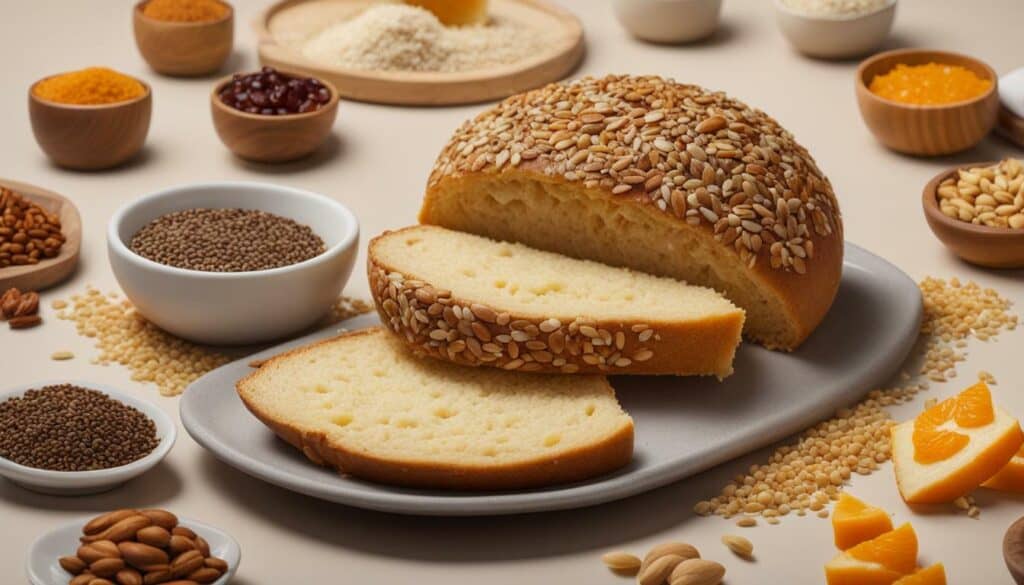
If you’re looking for a nutritious and waistline-friendly option, whole wheat bread rolls are a fantastic choice. With only 82 calories per slice, they are a healthier alternative to regular white bread rolls. Whole wheat bread rolls are made from whole grain flour, which contains the entire grain, including the bran, germ, and endosperm. This means that they retain more vital nutrients, such as fiber, vitamins, and minerals, compared to their refined counterparts.
Whole wheat bread rolls are not only low in calories, but they also provide a good source of dietary fiber, which can help promote a healthy digestive system and keep you feeling full for longer. The fiber content in whole wheat bread rolls can also aid in weight management by reducing cravings and preventing overeating. Additionally, these rolls contain essential nutrients, including iron, magnesium, and B vitamins, which are important for energy production and overall well-being.
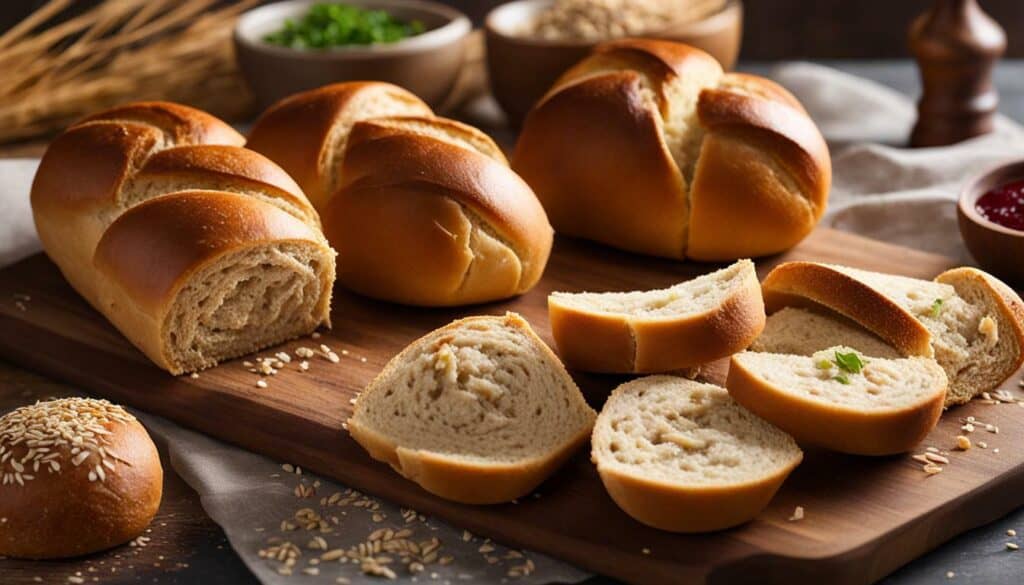
Choosing whole wheat bread rolls over regular white bread rolls can be a simple yet effective way to improve your diet. The added fiber and nutrients can contribute to better digestion, increased satiety, and overall better health. When shopping for bread rolls, be sure to check the label and opt for products that list whole wheat flour as the first ingredient. This ensures that you are getting the most nutritional value from your bread roll choice.
Remember, while whole wheat bread rolls are a nutritious option, portion control is still important. It’s easy to exceed your calorie intake if you consume large portions or load your bread roll with high-calorie spreads or fillings. To keep your calorie intake in check, pair your whole wheat bread roll with lean protein, such as turkey or chicken, and plenty of vegetables. This balanced approach will not only satisfy your taste buds but also provide the nutrients your body needs for optimal health.
Exploring Other Bread Roll Varieties
While whole wheat bread rolls are a great option, there are other varieties available that you might consider for different taste preferences or dietary needs. Let’s take a closer look at some of these alternatives and their calorie content per portion:
| Bread Roll Variety | Calories per Portion |
|---|---|
| White Bread Roll | 120 |
| Multi-Grain Bread Roll | 110 |
| Rye Bread Roll | 90 |
| Pumpernickel Bread Roll | 80 |
As you can see, the calorie content can vary significantly depending on the type of bread roll you choose. If you’re looking for a lower-calorie option, opting for a pumpernickel or rye bread roll might be a good choice. These varieties contain fewer calories per portion while still providing delicious flavors.
It’s also important to consider the ingredients used in bread rolls. Some varieties may be made with enriched flour, which can result in higher calorie content. On the other hand, bread rolls made with whole grains tend to be more nutrient-dense, offering additional fiber, vitamins, and minerals.
“I love indulging in a multi-grain bread roll with a low-fat spread for a satisfying and nutritious snack.” – Jennifer, Bread Enthusiast
Choosing the Right Bread Roll for You
- Consider your taste preferences and dietary needs when selecting a bread roll variety.
- Look for options that use whole grains for added nutritional value.
- Pay attention to the calorie content per portion to ensure it fits within your daily intake goals.
- Experiment with different varieties to find your favorites and add variety to your diet.

Exploring different bread roll varieties allows you to enjoy their delightful textures and flavors while considering your calorie intake. Remember to make informed choices and savor each bite!
Portion Control and Mindful Eating
Remember, even low-calorie bread rolls can contribute to weight gain if consumed in large quantities or alongside high-calorie ingredients. It’s important to practice portion control and mindful eating when it comes to enjoying bread rolls as part of a healthy diet.
One way to manage portion sizes is to use smaller bread rolls or cut larger ones in half. This allows you to still enjoy the taste and texture of a bread roll without consuming excessive calories. Pairing your bread roll with nutrient-rich toppings, such as lean proteins, vegetables, or spreads made from healthy fats, can add flavor and satisfaction without significantly increasing the overall calorie count.
Another strategy for mindful eating is to pay attention to your hunger and fullness cues. Take the time to savor each bite and eat slowly, allowing your body to register when it’s satisfied. This can help prevent overeating and unnecessary calorie intake.
By being mindful of your bread roll choices and practicing portion control, you can enjoy the deliciousness of bread rolls while still maintaining a healthy weight. Remember, it’s all about balance and making informed decisions that support your overall well-being.

| Bread Roll Variety | Calories per 100g | Calories per Portion |
|---|---|---|
| White Bread Roll | 250 | 150 |
| Whole Wheat Bread Roll | 200 | 120 |
| Multigrain Bread Roll | 220 | 132 |
| Seeded Bread Roll | 230 | 138 |
Maximizing Nutrient Intake with Whole-Grain Options
While whole wheat bread rolls are a good option, it’s worth considering whole-grain bread rolls for an extra boost of essential nutrients and dietary fiber. Whole grains, such as whole wheat, oats, and rye, are processed less than refined grains, retaining more of their natural nutrients and fiber content.
When you choose whole-grain bread rolls, you’re not only satisfying your hunger but also nourishing your body with vitamins, minerals, and antioxidants. These nutrients play a crucial role in supporting overall health and wellbeing. Whole grains are a good source of B vitamins, including thiamin, riboflavin, niacin, and folate, which are important for energy production, brain function, and the formation of red blood cells. They also provide minerals like iron, magnesium, and zinc, which are essential for various bodily functions.
Moreover, whole-grain bread rolls are rich in dietary fiber. Fiber adds bulk to your diet, making you feel fuller for longer, and helps maintain healthy digestion. It also helps regulate blood sugar levels and can contribute to a reduced risk of heart disease and certain types of cancer. By choosing whole-grain bread rolls, you’re making a smart choice for your health and wellbeing.
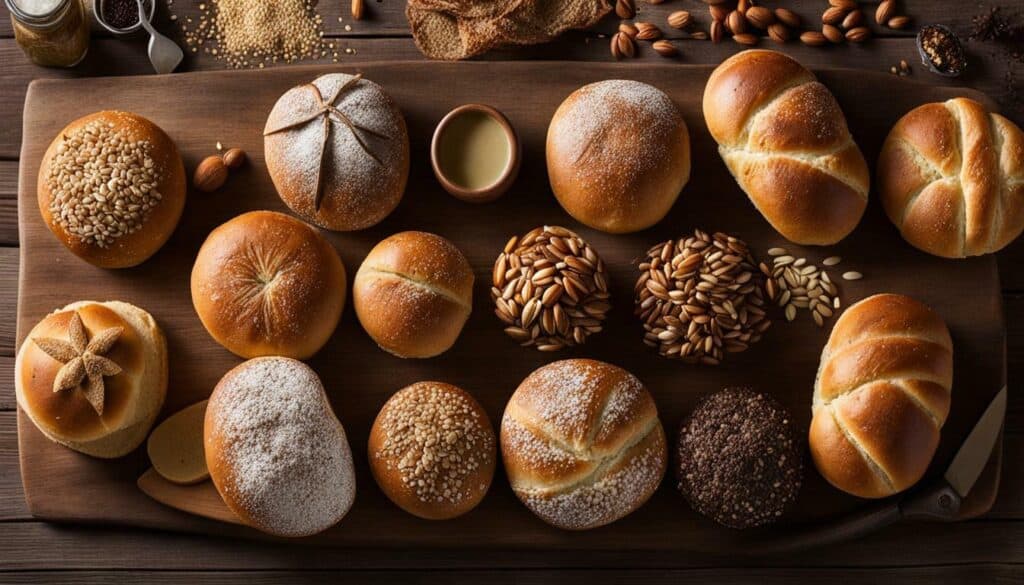
Here’s a table comparing the calorie content of different bread roll options per 100g:
| Bread Roll Variety | Calories per 100g |
|---|---|
| Whole Wheat | 256 kcal |
| White | 265 kcal |
| Multi-Grain | 277 kcal |
| Rye | 248 kcal |
| Whole Grain | 242 kcal |
As you can see, whole wheat bread rolls provide a moderate calorie count per 100g. However, it’s important to remember that portion sizes can vary, so it’s essential to check the serving size and adjust accordingly. By incorporating whole-grain bread rolls into your diet, you can enjoy a delicious and nutritious option that supports your overall health and weight management goals.
Bread Roll Calorie Comparison
To help you make informed choices, here is a calorie comparison of popular bread roll options per 100g:
| Bread Roll Variety | Calories per 100g |
|---|---|
| White Bread Roll | 250 |
| Whole Wheat Bread Roll | 210 |
| Multigrain Bread Roll | 220 |
| Sourdough Bread Roll | 200 |
As you can see, whole wheat bread rolls have the lowest calorie count per 100g compared to other popular varieties. This makes them a great choice for those watching their calorie intake.
It’s important to note that these calorie counts are approximate and can vary depending on the specific brand and ingredients used. Always check the packaging or consult a nutritionist for accurate information.

“Choosing healthier bread roll options can make a significant difference in your calorie consumption.”
Choosing the Right Bread Roll
When choosing bread rolls, aim for those made with whole grains as they tend to have more fiber and nutrients. Fiber helps with digestion and keeps you feeling full for longer, which can aid in weight management. Look for options that are lower in calories and avoid those that are high in added sugars or unhealthy fats.
Remember, portion control is also important. While bread rolls can be a part of a healthy diet, it’s best to enjoy them in moderation. Opt for smaller rolls or consider splitting a larger one with a friend or family member. This way, you can still satisfy your bread cravings without going overboard on your calorie intake.
Summary
In conclusion, being aware of the calorie content in bread rolls can help you make healthier choices and maintain a balanced diet. Whole wheat bread rolls are a nutritious option and have a lower calorie count compared to other varieties. By choosing whole-grain options more often, you can maximize your nutrient intake and support sustainable weight management. Remember to practice portion control and opt for healthier bread roll choices to ensure you’re on track towards your health and wellness goals.
Bread Roll Calories in Relation to Other Foods
To put bread roll calories into perspective, let’s compare them to the calorie content of other commonly consumed foods. It’s important to note that the calorie count can vary depending on the type and size of the bread roll. However, by being mindful of portion sizes, bread can still be enjoyed as part of a healthy diet.
Here is a comparison of bread roll calories per 100g:
| Bread Roll Variety | Calories per 100g |
|---|---|
| White Bread Roll | 250 |
| Whole Wheat Bread Roll | 220 |
| Multigrain Bread Roll | 230 |
| Sourdough Bread Roll | 200 |
| Gluten-Free Bread Roll | 180 |
It’s clear from the comparison that bread rolls contain more calories than some other commonly consumed foods. However, they also offer important nutrients, such as carbohydrates, protein, and fiber. It’s important to balance bread roll consumption with other nutritious foods to maintain a well-rounded diet.

Here are some examples of the calorie content of other commonly consumed foods per 100g:
- Apple: 52 calories
- Carrot: 41 calories
- Broccoli: 34 calories
- Cheddar Cheese: 402 calories
- Chicken Breast: 165 calories
- Hard Boiled Egg: 143 calories
- Chocolate Bar: 546 calories
- Potato Chips: 536 calories
As you can see, bread rolls generally have higher calorie content compared to fruits and vegetables. However, they generally contain fewer calories than high-fat or high-sugar snacks, like cheese or chocolate bars. It’s all about balance and moderation when it comes to incorporating bread rolls into a healthy diet.
Remember, the choice of bread roll can also impact the calorie count. Opting for whole grain or whole wheat varieties can provide more nutrients and fiber, making them a healthier choice overall. Be mindful of portion sizes and enjoy bread rolls as part of a well-balanced diet.
Tips for Incorporating Bread Rolls into a Healthy Diet
With the right choices and mindful eating, you can easily incorporate bread rolls into a healthy diet plan. Bread rolls can be a delicious and satisfying addition to your meals, but it’s important to opt for healthier options that provide nutritional value without adding excessive calories. Here are some tips to help you make the best bread roll choices for your weight loss journey:
1. Choose Whole-Grain Options
When selecting bread rolls, opt for whole-grain varieties whenever possible. Whole-grain bread rolls are made from whole wheat flour, which retains all the essential nutrients and fiber found in the grain. This means they not only provide fewer calories but also offer more vitamins, minerals, and dietary fiber that promote a healthy digestive system. Whole-grain bread rolls keep you feeling fuller for longer and can help you maintain a steady energy level throughout the day.
2. Watch Your Portion Sizes
While bread rolls can be a tasty and satisfying component of your meal, it’s essential to be mindful of portion control. Pay attention to the recommended serving size and avoid going overboard. One bread roll is usually considered a standard serving, but it’s important to consider your overall calorie intake for the day. Balancing your bread roll portions with other nutrient-dense foods, such as lean proteins and leafy greens, can help you create a well-rounded and healthy meal.
3. Experiment with Healthier Toppings and Fillings
Elevate the nutritional value of your bread rolls by experimenting with healthier toppings and fillings. Instead of slathering your roll with high-calorie spreads like butter or mayonnaise, opt for nutrient-rich options like avocado, hummus, or Greek yogurt. Adding lean protein sources such as grilled chicken or tofu along with a variety of fresh vegetables can make your bread roll more filling and satisfying without adding excessive calories.
Remember, incorporating bread rolls into your healthy diet plan is all about balance and moderation. By making informed choices and being mindful of portion sizes, you can enjoy the deliciousness of bread rolls while still achieving your weight loss goals.
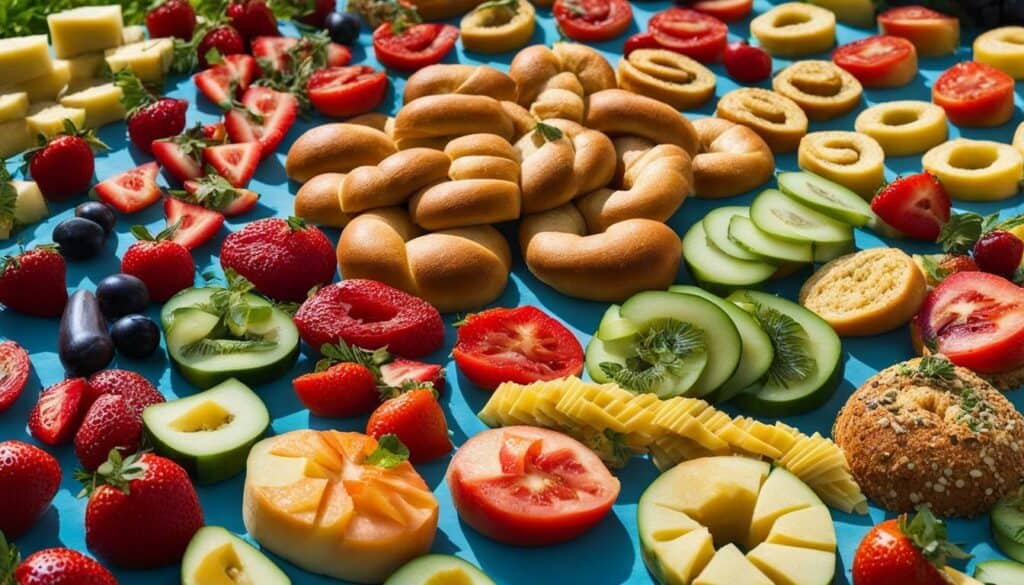
By making mindful choices when selecting bread rolls, you can maintain a well-balanced diet and support your weight management goals. There are several factors to consider when it comes to choosing the right bread rolls for a healthy lifestyle. One important aspect is the ingredients used in the bread roll. Opting for options that are made with whole grains, such as whole wheat or whole rye, can provide more nutrients and fiber compared to refined flour varieties.
Whole-grain bread rolls tend to be lower in calories and have a lower glycemic index, which means they release energy more slowly, keeping you feeling fuller for longer. Additionally, whole grains contain beneficial vitamins, minerals, and antioxidants that contribute to overall health.
It’s also worth noting that whole-grain bread rolls often come in different flavors and variations. You can find options like multi-seed, wholemeal, or even quinoa bread rolls, which provide an extra nutritional boost. These alternatives not only add more flavors to your meal but also provide a source of protein, healthy fats, and additional vitamins and minerals.
| Bread Roll Variety | Calories per 100g |
|---|---|
| Whole Wheat | 246 |
| Whole Rye | 259 |
| Multi-Seed | 292 |
| Wholemeal | 280 |
As you can see from the table, whole wheat and whole rye bread rolls tend to have fewer calories compared to multi-seed or wholemeal options. However, it’s important to remember that portion sizes also play a role in managing calorie intake. Choosing a smaller portion of a higher-calorie bread roll can still be a part of a healthy diet, especially when balanced with other nutritious foods.
Ultimately, it’s about finding the bread roll option that suits your taste preferences and dietary needs. Experimenting with different varieties can add excitement to your meals while keeping you on track with your weight management goals. Remember, moderation and balance are key to maintaining a healthy lifestyle.
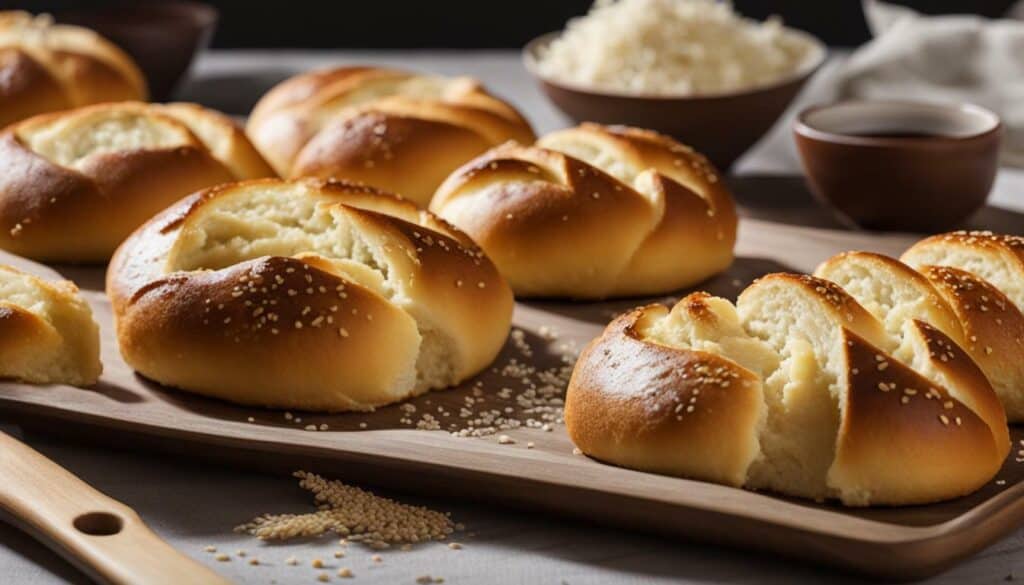
By considering the ingredients, calorie content, and portion sizes of bread rolls, you can make mindful choices that support sustainable weight management. Incorporating whole-grain options into your diet not only provides nutritional benefits but also contributes to overall well-being. Enjoying bread rolls as part of a healthy and well-balanced diet is possible with the right knowledge and mindfulness.
Conclusion
Counting your bread roll calories is a simple yet effective way to take control of your diet and make healthier choices for a balanced lifestyle. When it comes to bread rolls, the calorie content can vary depending on the type and brand. It’s important to be mindful of portion sizes and choose healthier options.
Whole wheat bread rolls are a nutritious choice, providing 82 calories per slice. They are packed with essential vitamins and minerals, making them a smart choice for those looking to maintain a healthy weight. However, it’s even better to opt for whole-grain options more often, as they offer more nutrients and fiber to keep you feeling satisfied.
It’s also helpful to compare the calorie content of bread rolls with other foods. While bread rolls may contain calories, they are still a lower-calorie option compared to many snacks and other processed foods. Incorporating bread rolls into a healthy diet can be done by being mindful of portion sizes and pairing them with nutritious ingredients like lean proteins and fresh vegetables.
In conclusion, counting your bread roll calories is an important step towards making informed choices about your diet. By being aware of the calorie content in different types of bread rolls, you can make conscious decisions that support your weight management goals. Remember, bread can still be part of a healthy diet, as long as you choose wisely and practice moderation.
FAQ
Q: How many calories are in different types of bread rolls?
A: The calorie content can vary depending on the type of bread and the brand. However, here are some general calorie counts per 100g and per portion:
Q: What is the calorie count of whole wheat bread rolls?
A: Whole wheat bread rolls provide approximately 82 calories per slice.
Q: Are there healthier options for bread rolls?
A: Yes, choosing whole-grain bread rolls more often is recommended as they offer more nutrients and fiber.
Q: What should I consider when consuming bread rolls?
A: It’s important to be mindful of portion sizes and practice mindful eating when enjoying bread rolls.
Q: Why are whole-grain bread rolls better for you?
A: Whole-grain options provide higher nutritional value and more fiber compared to other bread rolls.
Q: Can you provide a comparison of different bread roll options and their calorie counts?
A: While the calorie content can vary, here is a general comparison of bread roll options:
Q: How do bread roll calories compare to other foods?
A: Bread roll calories can be compared to other foods such as fruits, vegetables, and snacks. However, the calorie content may vary.
Q: How can I incorporate bread rolls into a healthy diet?
A: To enjoy bread rolls while maintaining a balanced diet, consider portion control and selecting healthier options.
Q: What are some mindful bread roll choices for sustainable weight management?
A: To support sustainable weight management, choose bread rolls with healthier ingredients and lower calorie counts.
How Many Calories Are in Bread with Butter?
Bread with butter is a scrumptious combination, but have you wondered about the calories in bread with butter? A typical slice of white bread contains around 80 calories, while a tablespoon of butter adds around 100 calories. So, indulging in a slice of bread with butter means consuming approximately 180 calories. It’s essential to keep track of your calorie intake for a balanced diet.

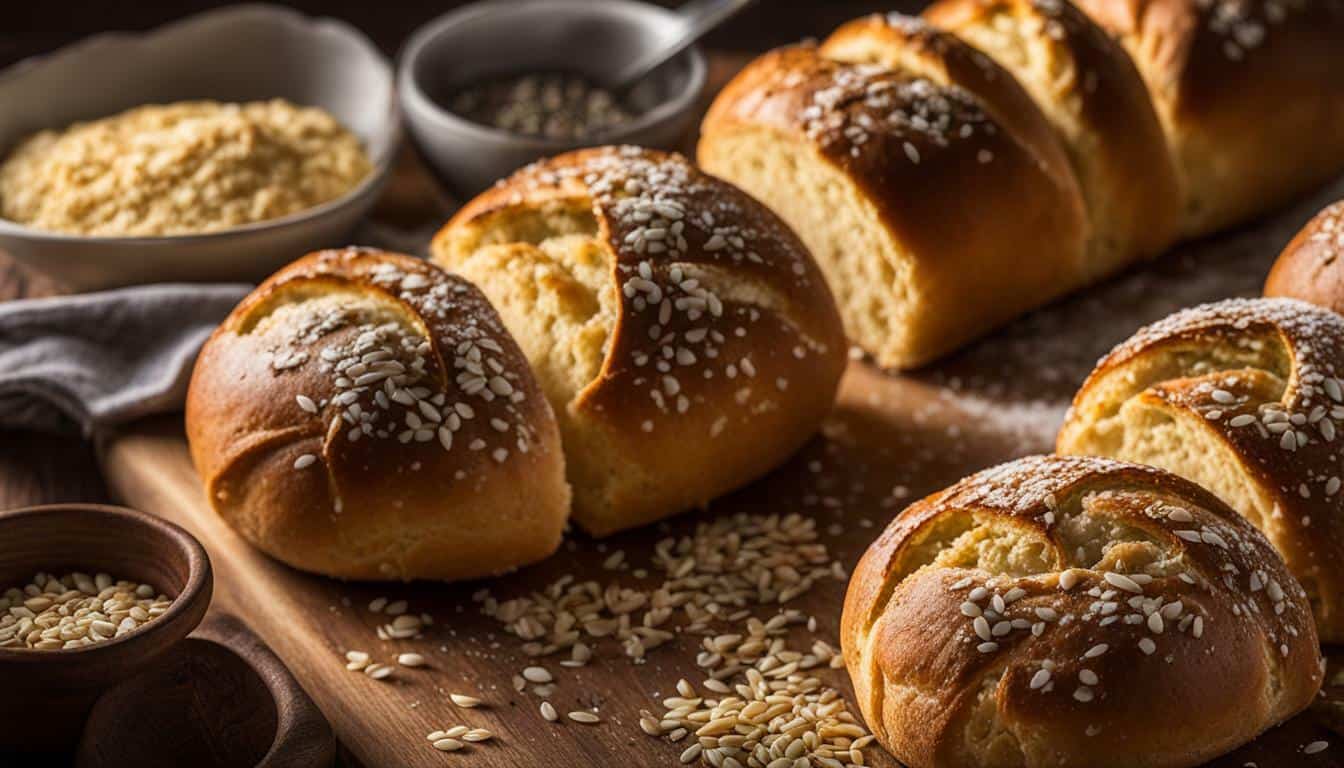



Leave a Reply